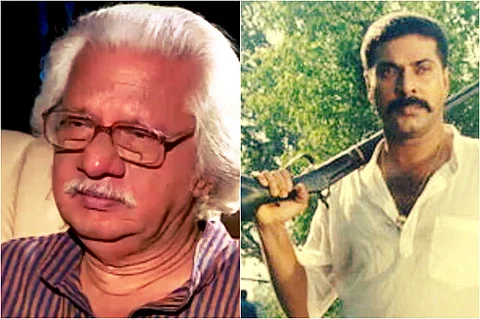

Gautaman Bhaskaran
Vidheyan, based on a Paul Zacharia work (Bhaskara Patelarum Ente Jeevithavum [Bhaskara Patelar and My Life], 1986), was the second adaptation by Gopalakrishnan. It is a deep analysis of servility in the wider context where the servant-master relationship takes on a strange hue.
After the initial anger, pain and reluctance, Thommi finds pleasure in this slavery and obedience to the extent that he even finds his wife’s sexual affair with Patelar exciting. In bed one night with his wife, Thommi says he likes the way she smells, Patelar’s expensive perfume having rubbed off on her. Such is the vicarious joy. It is only in the end when Patelar and Thommi are fugitives in the picturesque forest that they become equals, dressed alike and eating the same food—and from the same leaf.
This is the end of the sadistic bondage that Thommi had been in, and when he finds himself free he is confused. He does not know how to face it or cherish it. Vidheyan is a far more ambitious effort than Gopalakrishnan’s earlier films and probes into the psyche of the society rather than the individual. Patelar and Thommi at the two extreme ends of a wide spectrum help in this study. One represents absolute authority and the other absolute servility, both monstrous and distasteful in vastly different ways.
***
Vidheyan was shot inside Karnataka, close to the Kerala border. Gopalakrishnan and his team chose a spot there and built a toddy shop and a few other shops. The place after Sivan’s art endeavour resembled a street junction with a bus stop. When the set was complete and shooting was to begin, some Christian settlers who had their shops and houses there threatened to pull down their thatched roofs and replace them with tiles. This would have marred the period look of the place.
Adoor’s team pleaded with them not to do this until the shooting was over. The settlers demanded an unreasonably high sum of money to keep their thatches on. Finally, a compromise was reached after Meera Sahib and Zacharia went to the local Christian priest for help.
There was more drama to come. A rumour spread that there had been someone like Bhaskara Patelar around. The local Patelars had seemed annoyed that a film was being made on them. The rumour became wilder, when it was whispered that a rifle-toting Patelar would appear on the set. Well, the rumour turned out to be just that, a rumour, and no Patelar actually turned up. But Adoor says that a Patelar might have been part of the curious onlookers, keeping watch over the shoot! It was one of his most difficult movies.
The actual photography by itself was a Herculean task. The locations were often inside dense forests. Sometimes, there was no road at all there, and the heavy cinema equipment had to be lugged by men. The movie crew doubled up as coolies. A full-length feature could have been made on the making of Vidheyan. When it was shot, it was summer, the scorching heat and the parched land causing immense discomfort. But Gopalakrishnan, his principal actors, the cameraman and other crew members were not to be daunted. They carried on.
The auteur’s search for a waterfall was another adventure, though dangerous. Gopalakrishnan, Meera Sahib and Zacharia’s manager, Chandran Pillai, began a treacherous journey through dense foliage and growth—walking downhill and clearing vegetation with the help of choppers. Little did they know then that there was a highly poisonous king cobra close to where they were. However, it was worth the effort, and they chanced upon the waterfall.
The following day, after the camera had been set up and the actors had taken up their positions, the sky suddenly turned menacingly dark. It began raining heavily, and someone in the group warned the others that there could be flash floods. The moment Mammootty heard this, he ran for his life, climbing up the hill to reach for the road, and safety. Dressed in just a dhoti, he cut and bruised himself in panic. Not a flattering image for a superstar whose heroic deeds on the screen leave many envious. His reaction got the others nervous as well, and just about everybody was seen racing up the steep hillside towards the road.
The day may have been thrilling, but it was frustrating for Gopalakrishnan. The schedule could not be completed, and, worse, carting the heavy equipment up and down the steep incline was no joke. The film, however, turned out to be extraordinarily engaging. To begin with, Gopalakrishnan had a good plot to work on. Zacharia’s story was a classic that the scriptwriter in Gopalakrishnan tackled by adding details and giving it a completely new interpretation.
When one looks back and thinks about the movie, both Patelar and Thommi appear less disgraceful. They are in different ways hapless victims of situation. The only thriller in the Adoor oeuvre, Vidheyan was mostly shot at night to give that eerie feeling of fright and evil. When the shoot was wrapped up, Adoor says he felt trapped and wanted to escape. It was a terrible feeling of being boxed in. And he had to get out into the sunshine and feel a sense of liberation. He did by walking into a story that was dear to him. For, it was his own. Or almost.
Excerpted with the permission of Penguin Random House India from the book Adoor Gopalakrishnan: A Life in Cinema by Gautaman Bhaskaran.
You can buy the book here.